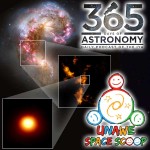Podcaster: Richard Drumm
 Title: Space Scoop: A Cosmic Dinosaur Egg Ready to Hatch
Title: Space Scoop: A Cosmic Dinosaur Egg Ready to Hatch
Organization: 365 Days Of Astronomy
Link : astrosphere.org ; http://unawe.org/kids/unawe1525/
Description: Space scoop, news for children.
Bio: Richard Drumm is President of the Charlottesville Astronomical Society and President of 3D – Drumm Digital Design, a video production company with clients such as Kodak, Xerox and GlaxoSmithKline Pharmaceuticals. He was an observer with the UVa Parallax Program at McCormick Observatory in 1981 & 1982. He has found that his greatest passion in life is public outreach astronomy and he pursues it at every opportunity.
Today’s sponsor: This episode of “365 Days of Astronomy” is sponsored by — no one. We still need sponsors for many days in 2015, so please consider sponsoring a day or two. Just click on the “Donate” button on the lower left side of this webpage, or contact us at signup@365daysofastronomy.org.
Transcript:
This is 365 Days of Astronomy. Today we bring you a new episode in our Space Scoop series. This show is produced in collaboration with Universe Awareness, a program that strives to inspire every child with our wonderful cosmos.
Today’s story is…
A Cosmic Dinosaur Egg Ready to Hatch
Globular clusters are the dinosaurs of space. They are huge groups of thousands and thousands of stars shaped like a globe, thus the name globular.
They have often been described as looking like a pile of diamonds on black velvet. And like dinosaurs, globular clusters are very large and formed a long, long time ago. Some globular clusters are almost as old as the Universe itself!
Surprisingly, astronomers have found, in a pair of colliding or merging galaxies collectively called the Antenna Galaxy, a globular cluster being made. It’s like finding a dinosaur egg in your backyard, ready to hatch!
A merging galaxy system is where two galaxies are colliding and combining into one single galaxy. This is a rather common occurrence in the Universe and it’ll happen to our own Milky Way Galaxy as we merge with the Andromeda Galaxy in a few billion years.
The team of University of Virginia and NRAO astronomers used the Atacama Large Millimeter/Submillimeter Array or ALMA to make the discovery. ALMA is the world’s most advanced radio telescope and is located in the Atacama desert of northern Chile.
A globular cluster can only form from the largest and densest gas cloud. When the universe was young, huge gas clouds were pretty common. That’s why globular clusters were born billions of years ago.
And just such a huge gas cloud has been discovered in that merging galaxy. One massive blob of gas inside this cloud is called “The Firecracker”, you can see it in the picture used in today’s album artwork.
The Firecracker appears to be big enough to create an entire new globular cluster. That’s enough material to make fifty million stars like our Sun! But no new stars have yet been born in the cloud. It’s like a ‘cosmic egg’, ready to hatch. We just have to wait a few million years and see.
Observing the formation of a globular cluster would be a bit like witnessing the birth of a Tyrannosaurus rex – something you would expect to happen in the very distant past.
Seeing it happen right now will teach astronomers a lot about things that occurred in the Universe long, long ago and help us understand just how we got to the Universe that we have today.
Hey Here’s A Cool Fact
The Antennae Galaxies have been colliding for around 300 million years! They’ll eventually merge into what’s called an elliptical galaxy. They were spiral galaxies before, but will loose all that pretty structure as they merge. Oh well. That’s the cookie crumbles and the way the Universe does its business!
Thank you for listening to 365 Days of Astronomy!
End of podcast:
365 Days of Astronomy
=====================
The 365 Days of Astronomy Podcast is produced by NUCLIO. Audio post-production by Richard Drumm. Bandwidth donated by libsyn.com and wizzard media. You may reproduce and distribute this audio for non-commercial purposes. Please consider supporting the podcast with a few dollars (or Euros!). Visit us on the web at 365DaysOfAstronomy.org or email us at info@365DaysOfAstronomy.org. This year we celebrate cosmic light as light is our info messenger in the universe. Join us and share your story to celebrate the International Year of Light. Until tomorrow! Goodbye!

